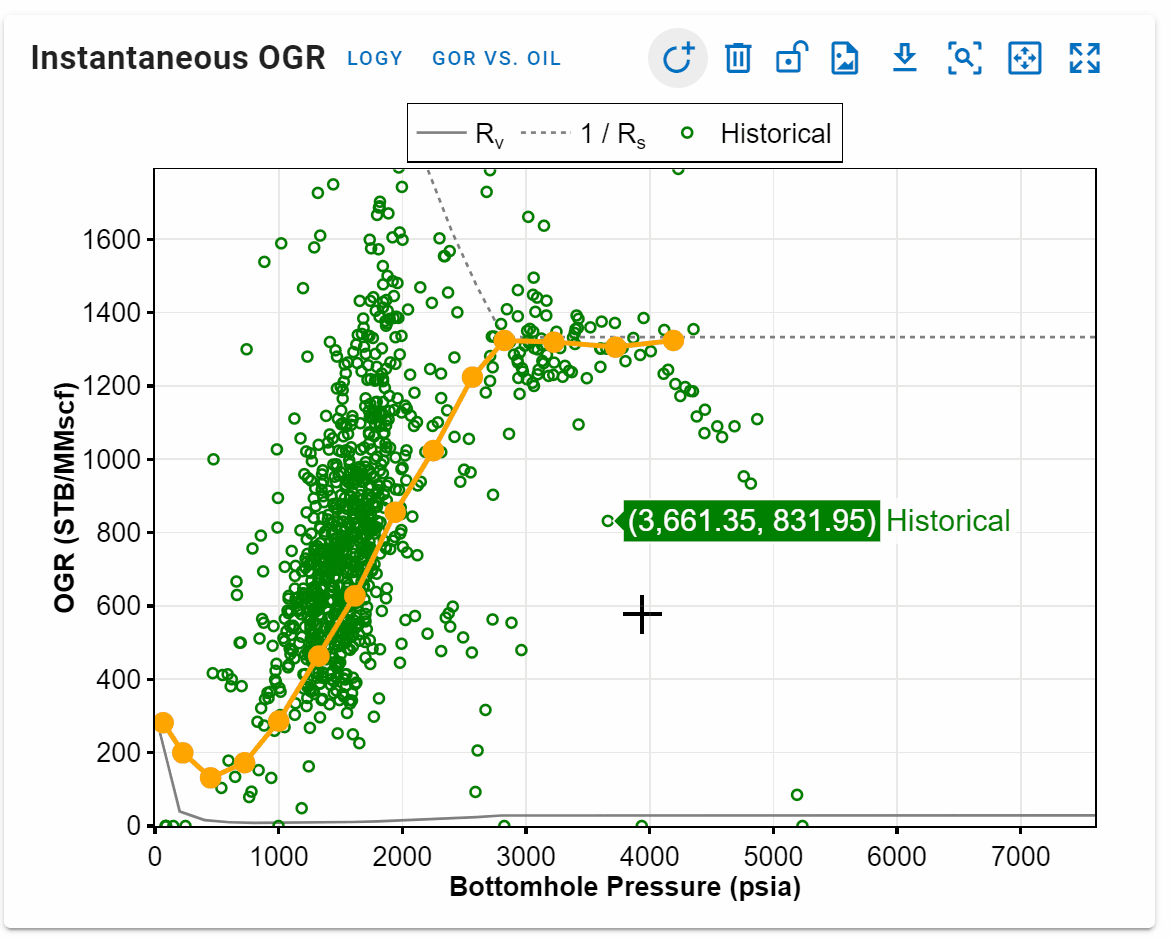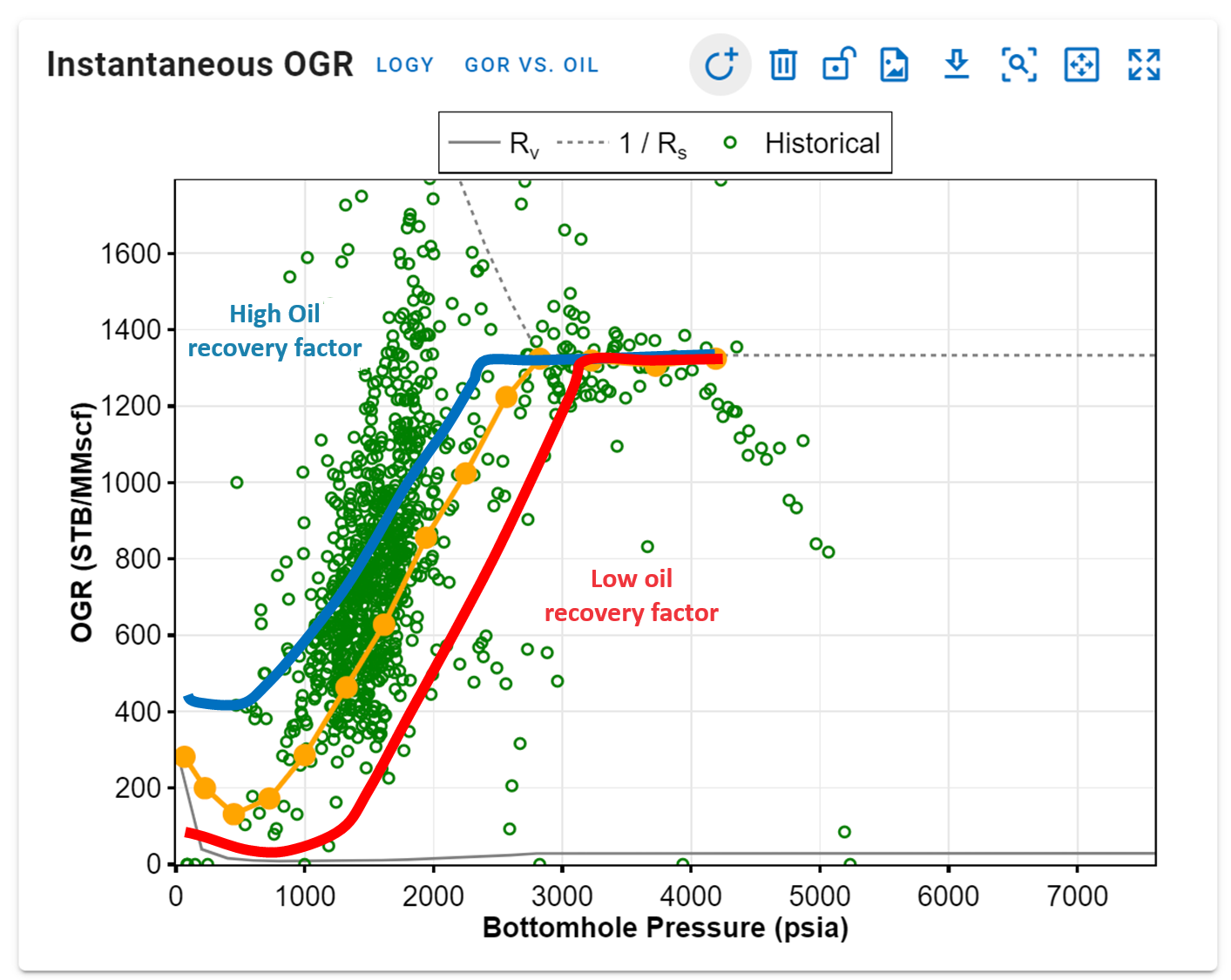Recovery Factor Prediction
1. Theory
One can determine forecast fluid rates in a daily basis by extrapolating the straight line from multiphase FMB analysis and assuming all the future data will honor the line.
The idea is to solve a quadratic equation to get predicted gas rates. Then, multiplying these gas rates with instantaneous oil-gas ratio \((ogr)\) and water-gas ratio \((wgr)\) to get oil and water rates, respectively. Since original hydrocarbons in place is known from previous analysis, recovery factor (RF) can be easily determined.
1.1. Requirements
This module only works if and only if a multiphase FMB analysis has been performed before. Additionally, this module requires:
- Contacted pore volume (\(V_p\)) and multiphase productivity index (\(b_M\)) from multiphase FMB analysis module.
- Extrapolated bottomhole pressure \((p_{wf})\) vs. time.
- Extrapolated flowing instantaneous oil-gas ratio \((ogr)\) vs. \(p_{wf}\).
- Extrapolated flowing instantaneous water-gas ratio \((wgr)\) vs. \(p_{wf}\).
Flowing \(ogr\) and \(wgr\) are obtained from multiphase FMB analysis.
1.2. Quadratic Equation Derivation
First, start with cumulative producing oil-gas ratio \((OGR)\) and water-gas ratio \((WGR)\) at day \(t+1\).
Please note that uppercase \(OGR\) and \(WGR\) have different definitions than lowercase \(ogr\) and \(wgr\).
As explained in multiphase flowing material balance section, cumulative producing \(OGR\) and \(WGR\) can also be written in terms of component concentrations as
Where the component concentrations of oil, gas and water (\(\zeta_o\), \(\zeta_g\) and \(\zeta_w\)) are defined
Subscripts \(o\), \(g\) and \(w\) represent oil, gas and water properties; while subscript \(i\) is for initial condition. Definitions and units for all variables can be seen in the nomenclature.
Combining these two definitions results in
Total saturation is denoted by
Thus, oil and water saturation (\(S_o\) and \(S_w\)) in terms of gas rate can be reckoned by rearranging Eqs. \eqref{Cum-OGR-Combined} and \eqref{Cum-WGR-Combined}.
in which the constants are
Second, mixture density is defined as
Subscript \(sc\) indicates standard condition. Substituting \(S_o\) and \(S_w\) in Eq. \eqref{Mixture-Density} with Eqs. \eqref{Oil-Saturation} and \eqref{Water-Saturation} in terms of \(q_g^{t+1}\) yields
where
Recalling multiphase FMB equation at day \(t+1\),
\(MBT_M\) indicates mass material balance time,
The mass flow rate is identified as
and \(M_T\) depicts the total cumulative mass of oil, gas and water,
Multiplying both sides in Eq. \eqref{Multiphase-FMB} by mass flow rate (\(\dot{m}\)) gives
Assume
Replacing \(\beta^{t+1}\) with Eq. \eqref{Beta}, \(M_T^{t+1}\) with Eq. \eqref{Cumulative-Mass-Produced-Total} and \(\dot{m}^{t+1}\) with Eq. \eqref{Total-Mass-Production}, then Eq. \eqref{Multiphase-FMB-2} can be rewritten as
By rearranging Eq. \eqref{Multiphase-FMB-3} in terms of \(q_g^{t+1}\), a quadratic equation is formed.
Where the constants are expressed as
1.3. Recovery Factor Calculation
After solving the quadratic equation, oil and water rate can be calculated as follows
Having calculated fluid rates, the cumulative productions as well as the recovery factor can be easily resolved.
2. Workflow
EUR Prediction
- Extrapolate \(p_{wf}\) vs. time starts from the last day of history data to the desired time.
- Extrapolate flowing \(ogr\) vs. \(p_{wf}\) and flowing \(wgr\) vs. \(p_{wf}\), ensure the extrapolations cover the range of \(p_{wf}\) from step 1. These will be the "predicted" data.
- At the start of the forecast, \(N_p^t\), \(G_p^t\) and \(W_p^t\) are the cumulatives at the last time of the historical data.
- Calculate the following properties for every time step:
- \(OGR\) and \(WGR\) by interpolating predicted data at \(p_{wf}\)
- Fluid properties (\(B_{o}\), \(B_{g}\), \(B_{w}\), \(R_{s}\) and \(R_{v}\)) by interpolating BOT data at \(p_{wf}\)
- Find fluid rates for every time step:
- Calculate saturation constants with Eqs. \eqref{Ao} to \eqref{Cd}
- Calculate mixture density constants with Eqs. \eqref{alpha-g} to \eqref{E}
- Calculate all constants for quadratic equation with Eqs. \eqref{A} to \eqref{alpha-d}
- Solve Eq. \eqref{Quadratic-Equation} by choosing the positive and largest root
- Calculate \(q_o\) and \(q_w\) using Eqs. \eqref{Oil-Rate} and \eqref{Water-Rate}, respectively
- Calculate cumulative production (\(N_p\), \(G_p\) and \(W_p\)) with Eqs. \eqref{Oil-Cumulative}, \eqref{Gas-Cumulative} and \eqref{Water-Cumulative}.
- Calculate recovery factor by using Eqs. \eqref{Oil-RF} and \eqref{Gas-RF}.
How to forecast \(CGR\) and \(WGR\) vs Pressure?
Regarding Extrapolating \(OGR\) and \(WGR\)
Rv and 1/Rs curves are generated from the EoS based on the PVT initialization.
Rv or the condensate gas ratio represents the minimum oil that will be recovered at the surface as condensate dropout from gas production.
This represents the minimum oil evolved from gas that would still be recoverable when the oil phase stops being mobile and only gas is flowing. Hence, this volatilized Oil-Gas ratio, forms the minimum bound of the OGR expectation.
1/Rs or the oil gas ratio represents the maximum oil that has to be recovered to produce a unit volume of gas from solution. This essentially makes the upper bound of the ratio forecast.
Your forecasts will always be well within these bounds.
\(OGR\) data above the saturation pressure will be very close to the 1/Rs line and the forecast needs to follow the data and reasonably extrapolate to lower pressures (upto the abandonment pressure). Water Gas Ratio is typically declining with decline in pressure.
Reducing Uncertainty in Ratio Forecasting - See analogs!
In case the yield/GOR is a strong function of flowing bottomhole pressure - The case may not vary much with the type of analog chosen (parent/edge/fully bound), instead the analog must have similar producing history of sufficient length.
In case the yield/GOR is a strong function of average reservoir pressure - Split the data from analog wells by the type and select the trend that closely matches the type of the well, since parent wells will have a lowest, flat GOR while an edge and fully bound cases have different, but both sharply increasing trends in comparison. The forecast built should be bounded by the analog wells with the fully bounded tight infill yields the sharpest increase in GOR while the parent well offers a minimum bound for the magnitude and the rate of change of GOR.
Finally, always use the Cumulative GOR vs Cumulative Oil to sanity check the forecast - realistically, you expect a linear increase with a concave up trend.
Impact of these forecasts on recovery factors
The oil EUR and recovery factors are far less sensitive and gas EUR may be slightly more sensitive to the constructed forecast in \(WGR\).
The most practical uncertainty you might face is the OGR ratio forecasting, which also has the highest impact on calculated recovery rates.
MFMB vs Numerical Model recovery factors
In MFMB, we forecast the ratios and use simple material balance equations to calculate Recovery Factors and EUR. We proceed in the opposite direction compared to the Numerical Simulations, where we run a numerical simulation to get the same ratios over time to ultimately calculate the Recovery factors and EUR.
Under the assumption that most unconventional wells produce from reservoirs with an expansion-drive, if the forecasted ratios and abandonment pressures are exactly the same in Numerical Model and MFMB, we get the exact same recovery factors and EUR as well.
3. Obtaining EURs from Recovery Factor Analysis
3.1. How can FMB methods be used to calculate EUR?
The FMB method solely calculates the contacted pore volume (e.g., \(OOIP_{contacted}\)). To determine the EUR, it is necessary to estimate the recovery factor.
Example: \(EUR_{oil}\) = \(OOIP_{contacted}\) x \(RF_{oil}\)
3.2. How do we estimate a recovery factor?
The multiphase FMB method employed in whitson+ (Thompson) does not require relative permeabilities as input. Consequently, for forecasting purposes, whitson+ uses a forecasting method that also doesn't require relative permeabilities, i.e. forecast the producing ratios directly. While all producing ratios are typically a function of PVT and relative permeabilities, having a forecast of the ratio vs. time eliminates the need for relative permeability data.

3.3. Comparison of methods for calculating recovery factors
Using recovery factor analysis feature from FMB, numerical modeling, or simple material balance method, the recovery factor will be identical as long as the producing \(GOR\) at the end of history and the abandonment pressure are the same.
3.4. How to validate if the ratio forecast makes sense?
Plot \(GOR\) vs oil. Check the forecasted points (grey) to see if they transition smoothly from the historical cumulative \(GOR\) . If the trend continues without breaks, jumps, or drops, the ratio forecast is reasonable. If you notice any sudden discontinuity, the data points may need to be adjusted to align smoothly with the historical cumulative \(GOR\) .

In cases where DCA EUR and MFMB EUR diverge, the \(CGR\) vs pressure curve can be modified to achieve alignment, thereby adjusting the recovery factor for oil.

4. Relevant videos
4.1. New Multiphase Flowing Material Balance Method
4.2. How to interpret the multiphase FMB plot?
4.3. Linking Multiphase Flowing Material Balance method to Recovery Factor Calculations
Nomenclature
| Variable | Definition | Units |
|---|---|---|
| \(B_g\) | Gas formation volume factor | RB/Mscf |
| \(b_M\) | Multiphase productivity index | RB/day |
| \(B_w\) | Water formation volume factor | RB/STB |
| \(B_o\) | Oil formation volume factor | RB/SRB |
| \(GIP\) | Gas in place | Mscf |
| \(G_p\) | Cumulative produced gas | Mscf |
| \(\dot{m}\) | Mass flow rate | lbm/d |
| \(M_g\) | Cumulative mass of surface produced gas | lbm |
| \(M_o\) | Cumulative mass of surface produced oil | lbm |
| \(M_T\) | Cumulative total mass produced | lbm |
| \(M_w\) | Cumulative mass of surface produced water | lbm |
| \(MBT_M\) | Mass material balance time | day |
| \(N_p\) | Cumulative produced oil | STB |
| \(OGR\) | Cumulative producing oil-gas ratio | STB/Mscf |
| \(ogr\) | Instantaneous producing oil-gas ratio | STB/Mscf |
| \(OIP\) | Oil in place | STB |
| \(p\) | Pressure | psia |
| \(p_{wf}\) | Flowing bottomhole pressure | psia |
| \(q_g\) | Gas production rate | Mscf/d |
| \(q_o\) | Oil production rate | STB/d |
| \(q_w\) | Water production rate | STB/d |
| \(R_s\) | Solution gas-oil ratio | Mscf/STB |
| \(R_v\) | Solution oil-gas ratio | STB/Mscf |
| \(RF_g\) | Gas recovery factor | - |
| \(RF_o\) | Oil recovery factor | - |
| \(S_g\) | Gas saturation | - |
| \(S_o\) | Oil saturation | - |
| \(S_w\) | Water saturation | - |
| \(t\) | Time | day |
| \(V_p\) | Contacted reservoir pore volume | RB |
| \(WGR\) | Cumulative producing water-gas ratio | STB/Mscf |
| \(wgr\) | Instantaneous producing oil-gas ratio | STB/Mscf |
| \(W_p\) | Cumulative produced water | STB |
| \(\beta\) | Mixture density | lbm/RB |
| \(\rho\) | Density | lbm/cuft |
| \(\zeta_g\) | Component comcentration of gas | Mscf/RB |
| \(\zeta_o\) | Component comcentration of oil | STB/RB |
| \(\zeta_w\) | Component comcentration of water | STB/RB |